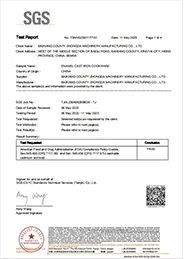
cast iron seasoning sticky
Understanding and Resolving Sticky Seasoning on Cast Iron
Cast iron cookware is celebrated for its ability to retain heat and provide superior cooking performance. However, one common issue that many users encounter is sticky seasoning. This problem can lead to frustration in the kitchen and negatively impact the cooking experience. In this article, we’ll explore the reasons behind sticky seasoning on cast iron and offer solutions to restore your cookware’s functionality.
What is Seasoning?
Seasoning refers to the layer of polymerized oil that creates a non-stick surface on cast iron pans and skillets. When you heat oil to its smoke point and allow it to cool, the oil molecules break down and bond to the surface of the cast iron, forming a protective layer. This not only provides a natural non-stick surface but also protects the pan from rust.
Why Does Seasoning Become Sticky?
There are several reasons why the seasoning on your cast iron might become sticky
1. Insufficient Heating When seasoning your cast iron, it's crucial to reach the oil's smoke point. Insufficient heat can result in a tacky residue that doesn’t fully polymerize.
2. Excess Oil Applying too much oil during the seasoning process can lead to a buildup of sticky residue. A thin, even layer is essential for proper seasoning.
3. Improper Cleaning Using soap or harsh scrubbers can strip away the seasoning. If you frequently clean your cast iron with strong detergents, this may be causing the seasoning to break down and become sticky.
4. Humidity Storing cast iron cookware in a humid environment can contribute to moisture buildup, which can affect the seasoning and lead to a sticky texture.
cast iron seasoning sticky

How to Fix Sticky Seasoning
If you find that your cast iron has developed a sticky coating, don’t despair! There are several methods to remedy this situation
1. Re-seasoning Start by scrubbing the sticky areas with coarse salt and a bit of water to remove the tacky residue. Once clean, thoroughly dry the pan and apply a thin layer of oil (flaxseed oil, grapeseed oil, or vegetable oil work well). Place the pan upside down in an oven preheated to 450°F (232°C) for about an hour. This will help to create a new, non-stick surface.
2. Baking Soda Paste For particularly stubborn spots, you can create a paste using baking soda and water. Apply it to the sticky areas, let it sit for a few minutes, and then scrub gently.
3. Avoid Over-oiling When you re-season, remember that less is more. A very thin layer of oil allows for proper polymerization, reducing the likelihood of stickiness.
4. Monitoring Temperature When heating your cast iron for cooking or seasoning, ensure that you reach the appropriate temperatures to avoid residue formation. Having a reliable thermometer can help.
Preventing Future Stickiness
To prevent sticky seasoning in the future, always clean your cast iron cookware properly after use—just hot water and a gentle scrub should suffice. Ensure it’s completely dry before storing it, and apply a very thin layer of oil if you won't be using it for a while. Additionally, try to store your cast iron in a dry place to minimize moisture exposure.
Cast iron cookware can be a joy to use, and with proper care and maintenance, you can keep it in excellent condition for years to come. Understanding the reasons behind sticky seasoning and learning how to remedy it will help you enjoy cooking with your cast iron without the hassle!
-
Season Cast Iron Perfectly with GPT-4 Turbo TipsNewsAug.01,2025
-
High Quality Cast Iron Cookware - Baixiang County Zhongda MachineryNewsAug.01,2025
-
Premium Cast Iron Pan: Durable & Perfect HeatNewsAug.01,2025
-
High Quality Kitchen Durable Black Round Cast Iron Cookware Pancake Crepe Pan-Baixiang County Zhongda Machinery Manufacturing Co., Ltd.NewsAug.01,2025
-
Cast Iron Cookware - Baixiang County Zhongda Machinery | Nonstick, Heat ResistanceNewsAug.01,2025
-
High Quality Kitchen Durable Black Round Cast Iron Cookware - Baixiang County Zhongda Machinery | Non-Stick, Heat Retention, DurableNewsJul.31,2025


